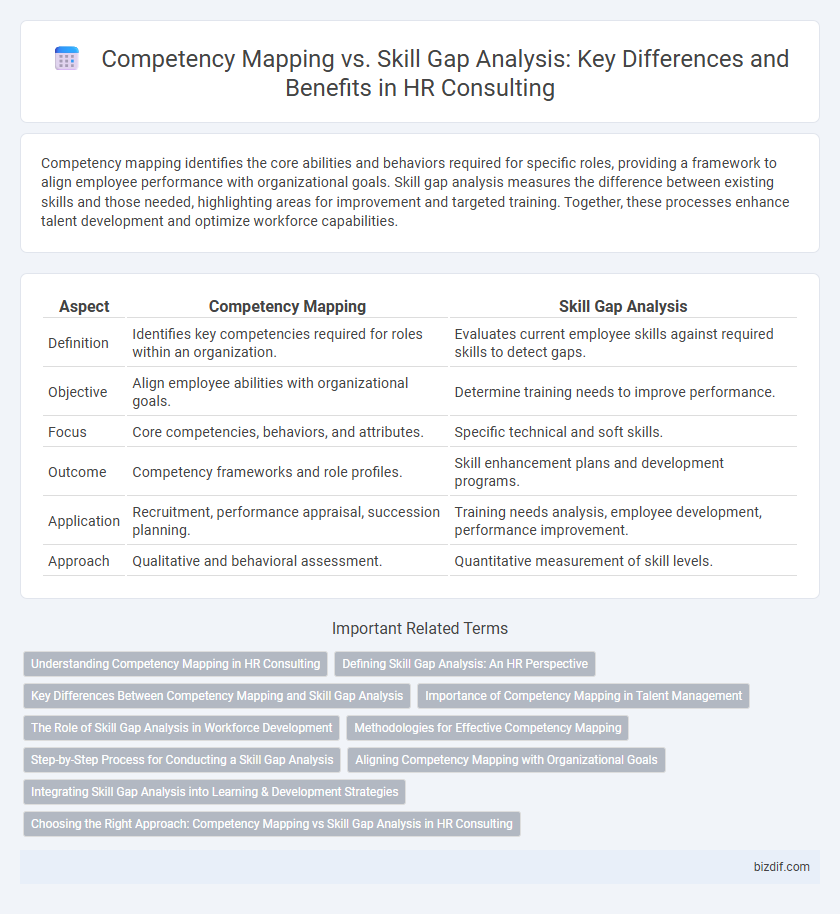Competency mapping identifies the core abilities and behaviors required for specific roles, providing a framework to align employee performance with organizational goals. Skill gap analysis measures the difference between existing skills and those needed, highlighting areas for improvement and targeted training. Together, these processes enhance talent development and optimize workforce capabilities.
Table of Comparison
| Aspect | Competency Mapping | Skill Gap Analysis |
|---|---|---|
| Definition | Identifies key competencies required for roles within an organization. | Evaluates current employee skills against required skills to detect gaps. |
| Objective | Align employee abilities with organizational goals. | Determine training needs to improve performance. |
| Focus | Core competencies, behaviors, and attributes. | Specific technical and soft skills. |
| Outcome | Competency frameworks and role profiles. | Skill enhancement plans and development programs. |
| Application | Recruitment, performance appraisal, succession planning. | Training needs analysis, employee development, performance improvement. |
| Approach | Qualitative and behavioral assessment. | Quantitative measurement of skill levels. |
Understanding Competency Mapping in HR Consulting
Competency mapping in HR consulting involves identifying key skills, behaviors, and attributes required for specific roles, ensuring alignment with organizational goals. This process helps create detailed competency frameworks that guide recruitment, training, and performance management, enhancing employee development and productivity. By accurately defining competencies, HR consultants enable targeted interventions that bridge skill gaps and elevate workforce capabilities.
Defining Skill Gap Analysis: An HR Perspective
Skill Gap Analysis in HR consulting identifies discrepancies between employees' current skills and the skills required for optimal job performance. This process involves assessing individual competencies against organizational benchmarks to pinpoint development needs. Accurate skill gap analysis enables targeted training programs, enhances workforce productivity, and supports strategic talent management initiatives.
Key Differences Between Competency Mapping and Skill Gap Analysis
Competency mapping identifies the specific knowledge, skills, and behaviors required for a particular role, aligning employee capabilities with organizational goals. Skill gap analysis evaluates the difference between current employee skills and those needed to meet job demands, highlighting where training and development are necessary. While competency mapping focuses on defining role expectations, skill gap analysis targets addressing deficiencies to enhance workforce performance.
Importance of Competency Mapping in Talent Management
Competency mapping plays a crucial role in talent management by identifying the essential skills, knowledge, and behaviors required for specific roles, enabling precise alignment of employee capabilities with organizational goals. It provides a strategic framework for recruitment, training, and performance evaluation, ensuring that talent development initiatives are targeted and effective. Unlike skill gap analysis, which focuses on current deficiencies, competency mapping offers a forward-looking approach that drives long-term workforce planning and succession management.
The Role of Skill Gap Analysis in Workforce Development
Skill Gap Analysis identifies specific deficiencies in employee capabilities, enabling targeted training programs that enhance overall workforce competence. This focused approach ensures resources are efficiently allocated to bridge gaps critical for organizational growth and adaptability. By systematically evaluating current skill levels against required competencies, companies can develop strategic initiatives that foster continuous employee development and improve performance outcomes.
Methodologies for Effective Competency Mapping
Effective competency mapping employs behavioral event interviews, critical incident technique, and competency-based assessments to identify key performance indicators and desired employee behaviors. Using these methodologies enables organizations to create precise competency frameworks aligned with strategic goals. This structured approach ensures targeted development plans and enhances workforce capabilities by addressing specific competency requirements.
Step-by-Step Process for Conducting a Skill Gap Analysis
Skill gap analysis involves a systematic assessment of employees' current skills against the competencies required for their roles, starting with defining key job competencies and collecting data through surveys, interviews, or performance reviews. Next, the identified gaps are analyzed to prioritize training needs and develop targeted learning interventions that address specific deficiencies. The final step includes monitoring progress through continuous evaluation and adjusting development plans to ensure alignment with organizational goals and evolving skill demands.
Aligning Competency Mapping with Organizational Goals
Competency mapping identifies the key skills and behaviors required to achieve organizational objectives, ensuring a strategic fit between employee capabilities and business goals. Skill gap analysis highlights discrepancies between current competencies and desired performance levels, enabling targeted training and development plans. Aligning competency mapping with organizational goals optimizes workforce potential, drives productivity, and supports sustainable growth.
Integrating Skill Gap Analysis into Learning & Development Strategies
Integrating skill gap analysis into learning and development strategies enables HR consultants to identify precise employee deficiencies, aligning training programs with organizational goals. Competency mapping provides a framework to assess essential skills and behaviors, while skill gap analysis pinpoints areas for improvement, ensuring targeted upskilling initiatives. This integration enhances workforce capabilities, boosts performance, and supports continuous professional growth within the company.
Choosing the Right Approach: Competency Mapping vs Skill Gap Analysis in HR Consulting
Competency mapping identifies the core behaviors, knowledge, and abilities required for specific roles, enabling HR consultants to align employee capabilities with organizational goals. Skill gap analysis evaluates the difference between existing employee skills and the skills needed for optimal performance, helping organizations target precise training interventions. Choosing the right approach depends on whether the focus is on defining role expectations (competency mapping) or addressing immediate skill deficiencies (skill gap analysis) for effective workforce development.
Competency Mapping vs Skill Gap Analysis Infographic

 bizdif.com
bizdif.com